It may pose a camouflage when you want to buy a nail gun, given the overwhelming varieties in their types. The imperative of this article is to explore different types of nail guns. That may help you decide which type you need and cut down much of your legwork while buying one.
The nail gun is a smarter and efficient alternative to the traditional hammer. You can drive a nail more accurately and faster than you can do with a hand hammer. Moreover, you can avoid the risk of getting your finger hammered by using a power nailer.
You can do with hammer-nailing if nailing is an occasional task for you. On the contrary, you can’t help opting for a nailer if you are a professional carpenter or even a weekend DIY warrior. Professional woodworking requires modern carpentry that involves nail guns for framing, roofing, trimming, and more. You can easily select the right nail gun for you only when you have full knowledge of different types of nail guns and their uses.
Read on to find the difference in nail guns and avoid the wrong investment.
What Is A Nail Gun, And How Does It Help You?
A nail gun, also called a nailer, is a powerful tool that keeps nails arranged by a coil or strip and shoots nails at pressure from a piston. It gains the name nail gun for the function of shooting. The piston gets the power from the pressure coming from a battery or an air compressor or gas.
Now, why does one need a tool like that?
Like a hammer, a nail gun can insert a single nail at one time, but the speed and accuracy make all the difference. With nailers, you can practically shoot many nails so long you want, or the project requires. But the manual nailing will bore you after driving several nails. Moreover, you cannot apply the hammer-nailing in tighter spaces where a nail gun can turn nailing into a fun play.
A nail gun is part and parcel of a professional tool arsenal. To be specific, carpenters, builders, construction experts, and roofing specialists can’t help without a nail gun. Keep reading to learn in-depth about the benefits of nail gun use. With the nail guns at your disposal, you will reap the following benefits.
Precision: You can shoot nails precisely and with utmost accuracy that is near impossible while driving nails with a hammer.
No Waste and Inconvenience: A nail gun inserts the nail wherever and which direction you want without bending or tilting the nail or damaging the workpiece. Conversely, you run the risk of both while depending on a hand hammer.
Safety and Zero Injury Nailing: It is a familiar scene to encounter hammered fingers; however, expert and experienced a carpenter is. Therefore, use a nail gun and enjoy zero injury nailing.
Productivity on Full swing: You can insert a nail with the push of a button with a power nailer. That faster alternative keeps you going on in full swing. And the mood of a craftsman is in no way impeded with slower and hazardous nailing alternatives.
Quality Craftsmanship: The accurate and to the point nailing to the correct depth and angle is the sweetest fruit of a power nailer. This upside of a nail gun results in better quality work and improves the craftsmanship in you.
Convenience: Carrying huge nails in a box is a hassle, but a nail gun gets you rid of this. A nail gun stow nails using a coil or strip and thus relieve you from carrying a box of pins on the go.
Types Of Nail Guns And Applications
All these benefits and advantages have made nail guns an essential tool. But the threat comes from the wide variety of nail guns. Therefore, what kind of nail gun do I need become the recurrent queries. A briefing on every category and different types of nail guns may make your preference easier.
Framing Nailers
When you are up to heavy-duty projects like framing the whole house, building something big, and extending your home or deck, you must go for framing nail guns. The framing nail guns can efficiently join 2*4’s as they can shoot nails up to 3-1/2″ size. For this, they offer a wide range of applications that include:
- Decks
- Homes
- Rooms
- Fences
- Wood siding
- Wood sheathing
Technological sophistication offers significant variations in models featuring interchangeable and sequential contract trip. To avoid adjusting hassle, the upgraded models of framing nailers come with a tool-free depth-drive reset.
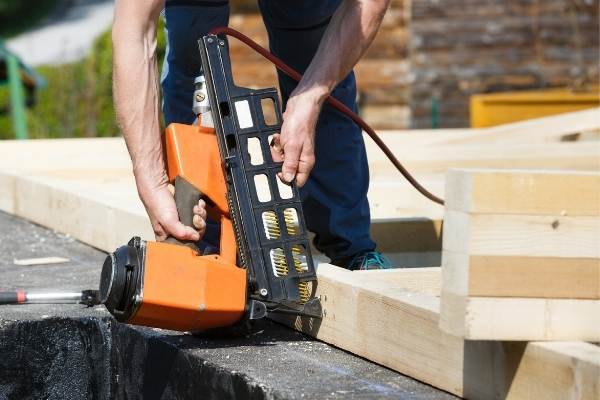
You have to decide on the right one for your need from various types of framing nailers having their respective upsides and downsides. Below you go with multiple subtypes of framing nailers.
Based on the power source, predominantly, there are two types of framing nail guns – Pneumatic framing nail gun and Cordless framing nailer. Here you go with a brief on each type:
A. Pneumatic Framing Nail Gun:
A pneumatic framing nail gun is powered by an air compressor that drives air pressure via a lengthy hose. The compressed air put pressure on the piston to drive nails into the workpiece.
B. Cordless Framing Nail Gun:
The cordless version functions much the same but is powered from a disposable air canister stowed inside the nailer. The compressed air canister, in conjunction with a battery, supplies the power to drive a fixed/limited number of nails. You have to replace that canister with a fresh one every time the set number of nails is pushed.
Based on the nail they use, they also are two types:
A. Clipped Head Framing Nail Gun:
Clipped head is the type able to hold far more nails that free you from the distraction of nail reloading.
B. Roundhead Framing Nail Gun:
The second type – roundhead – holds a low number of nails. But as a convenience, they will give you a firm holding power, and no building code is an obstacle to use it.
Based on magazine angle, framing nailers can be categorized into the following two types:
A. Stick Framing Nail Gun:
This kind of framing nailer uses a long stick-style magazine holding multiple sets of nails. It can arrange hundred of nails depending on the size of the nails.
B. Coil Framing Nail Gun:
Some framing nailers have a coil around the magazine. In functioning, they differ a little, and so the choice between the two is a matter of liking.
Finish Nail Gun
There are precision works like building furniture, doing molding, and installing trim that depends heavily on nailing. The said jobs require a finishing nailer to achieve accuracy and precision in the end product. For which you need to fire precision nails of 15-gauge/16-gauge. None but the finishing nail guns can handle these delicate and sensitive nails with the required accuracy and care. That is why they are called the best nail gun for building furniture.
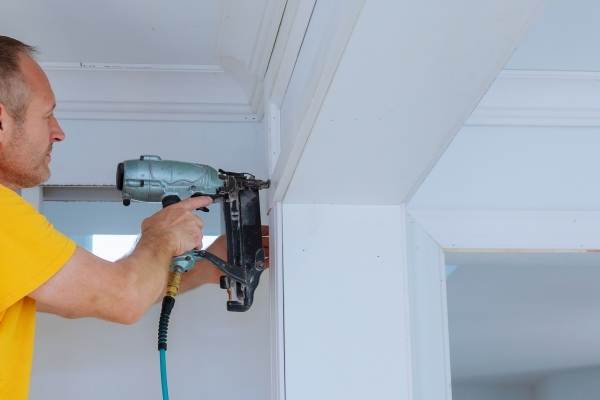
To be precise, you can use finish nail guns for:
- Finish carpentry work
- Crown molding
- Baseboard
Finish nails tend to be slightly bigger, so finish nailers can successfully deal with bulkier and massive wood pieces. Moreover, they have a higher holding power to avoid reload generated fatigue.
Finish nailers offer two categories judging by the operating power:
A. Pneumatic Finish Nailer:
The majority of the finish nailers you will see in the workshop are types of pneumatic nail guns. An air compressor powers them, and you can drive plenty of nails with that so long the compressed air is active to run the tool.
B. Cordless Finish Nailer:
The cordless alternative has a fuel cell instead of compressed air for nail shooting. While deriding of the hose, this cordless option needs to replace the fuel cell after 500-nail propulsions at one go. But the compressor type needs no extra cost like that.
The battery-Charged Units offer the best nail gun for small projects, and you can use it anytime so long it is charged.
Brad Nailer
The name signifies that brad nail guns shoot ultra-thin nails or brads. For a more precise idea, brads are nails having a diameter of 0.047″ or nearly 1.2mm. When accuracy and precision are more crucial, and you don’t want to damage the workpiece, your go-to option is brad nailers.
The brad nails are 18-gauge and perfect for maintaining accuracy. They are so thin that the holes created by them are scarcely visible. Therefore, you need the nailers when you are up to woodworking projects that require minimal holding strength.
They include:
- Jewelry box
- Birdcages
- Thin trim
- Molding
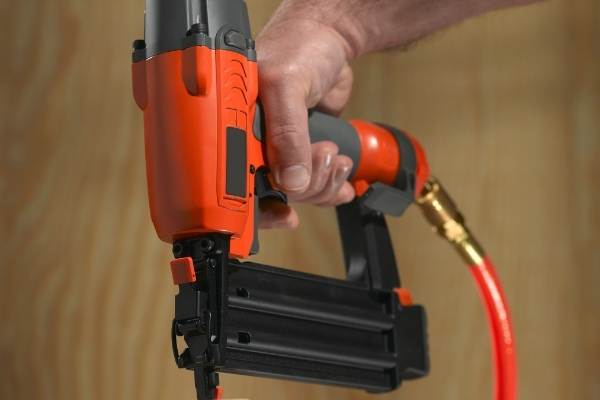
Contractors very often paused by a hesitation which nailer to go for – Pin nailer or Brad nailer. Knowledge of the subtle difference between them can be salvation. Brad nailers can handle 18-gauge nails, whereas pin nailers cannot deal with bigger nails. So, finish works, requiring a bit bigger nail, must be handled by brad nail guns.
Any tool has its subtypes, and brad is not an exception in this case. You have either Pneumatic or Electrical/Cordless brad nail guns.
A. Pneumatic Brad Nailer:
Not different from other pneumatic nailers, it is attached to an air compressor hose. The pneumatic nail gun applies air pressure to shoot the brad nails into the target workpiece. As long as you have the nails and air pressure coming from the compressor, this kind of nailer will keep firing nails on the working surface.
B. Cordless Brad Nailer:
A cordless brad nailer or an electric brad nailer is one that is powered by rechargeable battery units. An electric brad nailer, like other electric nail guns, is a smart and comfortable alternative when the project requires limited nailing. You are good to go without setting up an air compressor and harassed with a hose attached.
Roofing Nailer
Do you know what makes roofing nailers different from others? This is a job-specific nail gun meant only for work on roofs. They are used for nailing down the roof shingles – asphalt or fiberglass, waterproof tar paper, and insulation board. But they are heavy-duty nail guns found only with professional contractors. Though scarce, DIYers may keep one to embark on a weekend roof nailing.
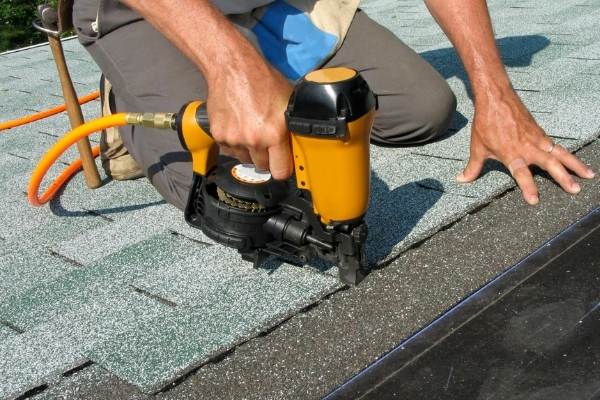
Roofing nailers are fast and drive nails into roofing materials like wood and other stuff at incredibly fast speed.
I like to share a key feature of roofing guns with you. They are built to drive coil nails – more specifically, coil roofing nails. Coil style magazines are intended to give you a longer run time between the two refills. So the need to stop and climb off a rooftop to reload the magazine is minimized. Coil magazine will also help to improve the ergonomics of the tool, making it less stubborn about keeping hold of while sliding around on a roof.
Based on the internal mechanism, we’re found a few different types of roofing nailers. These are:
A. Spring Loaded:
The simplest of the roofing nailers that keeps nails arranged in the spring to shoot nails out to push fast.
B. Pneumatic:
You can sense from the name that a pneumatic roofing nail gun is an air compressor powered nailer. They are the popular most in this type as they can run longer than their fellow nailers.
C. Solenoid:
They run on the power produced from electromagnetic polarization. Whereas the function sounds complicated, but the nailers are efficient to make the nailing task easier. Cordless roofing nailers are falling into this category.
Flooring Nailer
The successful laying of floorboards on the floor is key to living comfort. One particular nail gun called flooring nailer can serve this purpose the best. They do not look like the typical nail gun, but this should not be a deal-breaker. They are specially engineered to put floorboards at the proper angle and depth. To eliminate haze, you place the nailer just at the edge of the board, and then a nylon mallet hits the plunger. Thus the nail is shot accurately following the said method. Now you know that it can work.
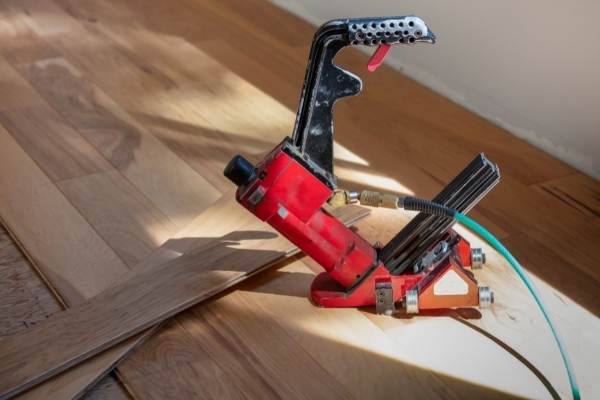
Like the framing nailer, this also has two types – Pneumatic and Manual.
A. Pneumatic Flooring Nailer:
Both the nailers share the same operation, but the pneumatic nail driver differs in using a power source. Air compressor causes the necessary pressure to make pneumatic nail gun drive nail into the floorboards.
B. Manual Flooring Nailer:
They are simplistic in the two categories of flooring nailers. And they run purely on muscle energy and require two hits from the bumper – first one to position its cleat and second hit- to activate the hand nail gun. Manual flooring nailers are more affordable and easy to operate but not meant for heavy-duty and bigger projects.
Flooring nailers offer one application, and that is to lay floorboards.
Siding Nail Gun
You have already got the point that a nail gun is a tool meant for meticulousness and exactness. Siding nail guns are crucial for installing sides, but we all know that this can be done away with framing nailers.
But to be exact, you need the siding nail gun with a wider head that can efficiently handle shorter nails sized between 1-1/4″ – 2-1/2″. While framing nailers are fit for longer nails that will not perfectly support siding installation.
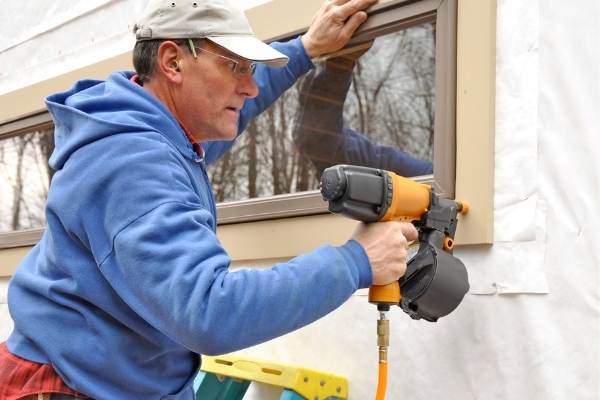
They are powerful enough to put join pieces together. You can attach thinner wood pieces and even synthetic material with a wood mount. When dealing with synthetic material, go for models compatible with that type of nail – aluminum nails.
Yes, siding nailers also are of two variations- pneumatic and cordless.
The pneumatic versions are preferable to the other. Most of the air pressurized siding nailers offer a good range of functional air pressure – 70 PSI to 120 PSI. The cordless or electric siding nail guns are for occasional and scarce use.
Palm Nailer
If you want to insert nails in a tighter or congested space, traditional hammering and typical nail gun both may despair you. In this circumstance, a particular type of nail gun known as a palm nailer may come to your rescue. Yes, it can push nails in extremely tight spaces that other nailing options will find impossible.
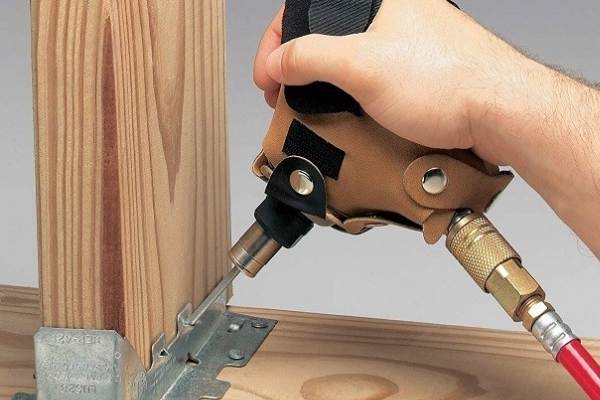
The name suggests the mini size of the nailers. They and their standard size counterparts share the same functional process while pushing a nail. The difference lies in the scale. Sitting on the palm, it can drive one nail at a time. Not to slip out of your hand at use, it comes with a strap to fasten hand.
Palm nailers are the only alternative to:
- Tight Space
- Joist hanger
- Smaller projects
The best side of using a palm nailer is that the small and lighter will not break your hand even after long hours. Thus you can go on working without suffering fatigue. Moreover, nailing goes more accurately with this because of the extra control over the small size tool.
To your surprise, the light and small nailing tool can handle several sizes of nails. The basic palm nailers can drive 1.5-3.5″ size nails with ease. But their heavy-duty models can push nails starting from 2″ to 6″.
On the flip side, they cannot drive more than one nail at a time. But this is compensated as most often palm nailers are come free of cost with the larger models or at a nominal price.
Like any other nail guns, palm nailers too have two subtypes – Pneumatic and Cordless. We have already learned how these two variations work. And the air compressor-run palm nailers are more famous for the length they can work.
Pin Nailer/Pinners
While inspecting wooden toys and upholstery works, you will come across nails with the nominal diameter – mostly headless or slight-headed. These are the nails you need a particular nailer called Pinners to handle them delicately.
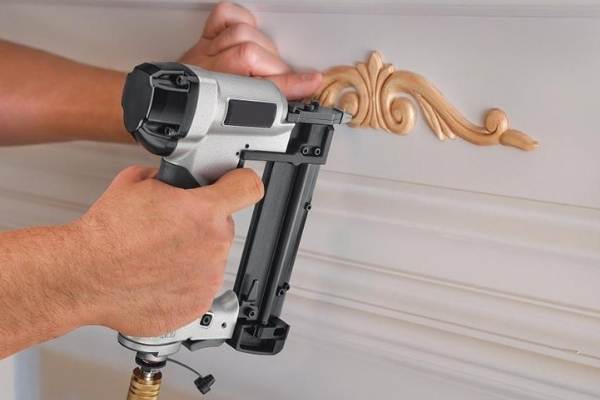
These types of nailers are 23-gauge pin nail guns and successfully deal with the said nails meant for work requires nominal or trivial holding power. Most of the time, you need that nailer to keep trims temporarily glued to anything. As their diameter suggests, they offer near-zero holding power, but with adhesives, they just serve the purpose. This is enough of them to keep things in place so long the glue or adhesive does not dry.
Pin nailers find them frequently used by professional carpenters who very often need finishing in their projects. And the frequent and typical uses are:
- Finishing work for carpentry projects
- Crown molding
- Delicate trim in toys and upholstery
- Cabinetry
- Thin veneers
- Small furniture trimming
A pin nailer is to deal with delicate pieces to avoid chipping or splitting the material if the deal with larger nails.
They have two subtypes – Pneumatic and Cordless. The preferable option is the one that runs on the air coming from an air compressor attached to the nailer.
Staple Gun
Yes, there are staple guns to staple harder and denser material than paper. A staple gun can drive nails into various surfaces like wood and plastics. The variety in their shape and size speak volume for their popularity and wide applications.
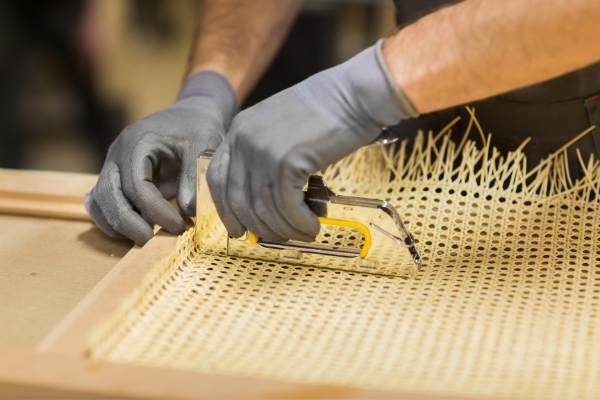
You can have staple nail guns in three variations judging by the running power. They include electric or cordless, pneumatic, and handheld. The manual staple gun is easy to load and very portable but slow in use to tire you. The electrical variation is less tiring and preferable for heavy-duty projects. And the pneumatic version is the most powerful of the three and runs on compressed air.
The staple gun, known as crown stapler, looks different from usual nail guns. The nails they drive to fasten the target material are u-shaped, and they do nailing fast. You will find it very useful for:
- Upholstery
- Carpeting
- Carpentry and other repairing in home
- Construction works
Given the various types, shapes, and power sources, it is the specific need that determines the product you go for.
Punch Nailer
If you are up to recycling wood pallets and wooden cases, you have to deal with numerous nails joining various parts. Either you have to cut those or remove them. You will go for the second option, and the best tool to help you in this regard is a punch nailer. Thus you have used nail guns to repurpose saving your money.
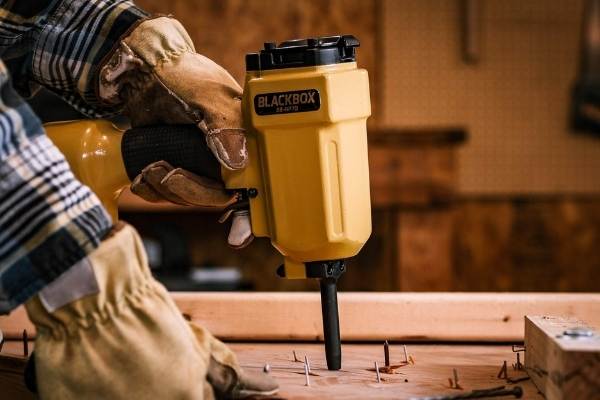
You can remove hundreds of stubborn nails at an incredibly fast speed. Thus a punch nailer saves you time, labor, and nails.
You will have two variations here too:
Pneumatic Punch Nailer:
It runs on compressed air to push the nail into materials. This variation is pretty powerful to drive nails in nearly zero ramp-up time. It offers increased nail driving or pulling speed.
Electric punch nailer:
You can opt for a cordless punch nailer, which is very handy to work with. Cordless punch nail guns run on battery. Better to choose a lithium-ion battery to go lighter while driving nails.
Punch nail guns are compatible with a wide range of nail sizes that ranges from 9-14 gauge nails. Punch nailer is a must for construction works.
Therefore, professional contractors, as well as DIYers, go for:
- Construction works
- Reuse wood
- Repurpose other materials
Frequently Asked Question (FAQ)
What type of nail gun do I need?
Ans: Given the different types of nail guns and subtypes of every nail gun, it is tough to determine which nail gun you need. That apart, the attentive reading of this article on types of nail guns should enable you to reach the right nail gun you need. It is best to be preferred by the type of nailing your project requires.
How does a pneumatic nail gun work?
Ans: Almost all the types of nail guns and their subtypes do have their pneumatic variation or air-powered nail gun. It is powered by an air compressor attached to the nail gun. When the air compressor is run, the compressed air travels faster via the hose and puts pressure on the piston of the nail gun. Thus the piston shoots the nails on the surface. They are also called air nail guns. To know more details you may visit this page.
What is the best nail gun for building furniture?
Ans: The best nail gun for building furniture is the finish nail gun. Besides, the pin and brad nailers are useful to finish carpentry work.
What is the best nail gun for baseboards?
Ans: Baseboards are made of dense wood pieces requiring long and bigger nails to join effectively. In this consideration, finish nail guns are the best option as they can successfully fire 15-16 gauge nails and drive into the object.
What is the best nail gun for framing?
Ans: Yes, You have a good guess if you have presumed already that the answer to framing work is the framing nail gun. A framing nail gun can shoot 3-1/2″ size of nails and can join 2*4’s. If you really need the best framing nailer, you might like to check out our honest and useful list of framing nail guns to save you from the intimidating task.
What is the difference between a brad nailer and a finish nailer?
Ans: The fundamental difference between the brad nailer and finish nailer is that the brad nailer fire 18-gauge nails and the finish nail gun handle 16-gauge/15-gauge nails. To point out more contrast, you use the finishing nailer mostly in woodworking and carpentry, whereas you the brad nailer to putty the nominal hole.
Conclusion
You want to take a nail gun means that you have a practical purpose for it. It should be the case that either you are a professional carpenter or construction contractor, a DIY enthusiast, or an individual making home improvement very often. Whatever the level of skill you have or user you are, reading this guide on the different types of nail guns would certainly take you to the right nail gun type you need and want. And once you have the right or best nail gun, you are ready to finish the toughest jobs with ease and speed.
If you run short of time, you scan the article and have a glance at the names of the various types of nailers and their subtypes. Certainly, you can have a good idea of the works and projects a particular nail gun is meant for. For people on the rush, a link is available with the respective category. So, enjoy nailing with the right and best nailer.
Recent Posts
Woodworking in 2025 is all about efficiency, precision, and smart technology. Whether you're a beginner or a seasoned craftsman, having the right tools can make all the difference. Here are the top 7...
Ever tried drilling into a piece of wood only to end up with a splintered mess or a wobbly hole? Yeah, it's more common than you think. Wood might seem like an easy material to work with, but...

